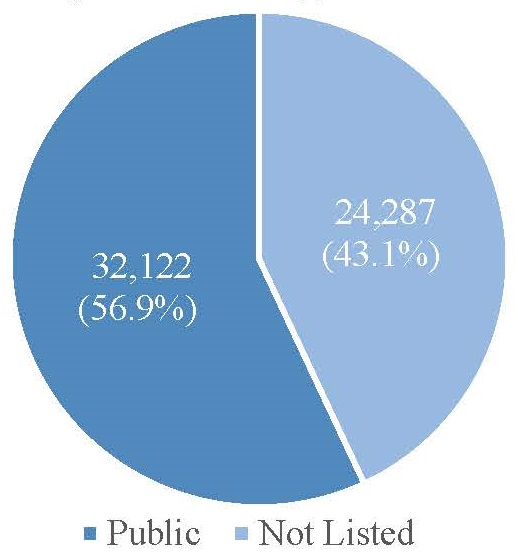Printer Friendly Version in PDF Format (3 PDF pages)
ABSTRACT
A large proportion of DATA-waivered providers choose not to be publicly listed on the SAMHSA website. Greater proportions of physician assistants and nurse practitioners, compared to physicians, opt to be listed on the SAMHSA website.
This brief was prepared through intramural research by the U.S. Department of Health and Human Services, Office of the Assistant Secretary for Planning and Evaluation, Office of Disability, Aging and Long-Term Care Policy. For additional information about this subject, visit the DALTCP home page at https://aspe.hhs.gov/office-disability-aging-and-long-term-care-policy-daltcp or contact the author x at HHS/ASPE/DALTCP, Room 424E, H.H. Humphrey Building, 200 Independence Avenue, S.W., Washington, D.C. 20201, Mir.Ali@hhs.gov.
DISCLAIMER: The opinions and views expressed in this report are those of the authors. They do not reflect the views of the Department of Health and Human Services, the contractor or any other funding organization. This report was completed and submitted on March 22, 2019.
In recent years, the Federal Government has made several efforts to increase access to buprenorphine for the treatment of opioid use disorder (OUD). Such efforts include expanding the types of providers eligible to treat OUD using buprenorphine in office-based practices and increasing the limits on how many patients waivered providers can treat at one time. The Drug Addiction Treatment Act (DATA) of 2000, as amended, authorizes waivers allowing qualified practitioners to treat OUD using buprenorphine outside federally registered opioid treatment programs. In contrast, providers who treat OUD using methadone must do so only in federally registered opioid treatment programs.
The Substance Abuse and Mental Health Services Administration (SAMHSA), which manages the DATA waiver process, maintains an online tool for finding DATA-waivered providers, the Buprenorphine Treatment Practitioner Locator.[1] DATA-waivered providers may opt to be listed publicly on the SAMHSA website. As shown in Figure 1, a large proportion of DATA-waivered providers choose not to be listed on the SAMHSA website. Little is known about the characteristics of providers who opt to be publicly listed.
| FIGURE 1. DATA-Waivered Providers by Public Listing Status |
|---|
 |
Using administrative data from SAMHSA on all DATA-waivered providers in November 2018, this data brief analyzes some characteristics of waivered providers who opt to be publicly listed.
FINDINGS
Greater proportions of physician assistants (PAs) and nurse practitioners (NPs), compared to physicians, opt to be publicly listed on the SAMHSA website (Figure 2). DATA waivers were initially available to physicians only. The Comprehensive Addiction and Recovery Act of 2016 authorized a pilot program permitting PAs and NPs to qualify for DATA waivers. The SUPPORT for Patients and Communities Act, enacted in October 2018, made the pilot permanent.
| FIGURE 2. DATA-Waivered Providers by Public Listing Status and Provider Type |
|---|
 |
Greater proportions of DATA-waivered providers with higher patient limits opt to be publicly listed on the SAMHSA website (Figure 3). Providers with 275 patient limit were 35 percentage points more likely to be publicly listed compared to providers with 30 patient limit. DATA-waivered providers were initially limited to treating no more than 30 patients concurrently. The Office of National Drug Control Policy Reauthorization Act of 2006 allows them to increase the patient limit from 30 to 100 after a year. A 2016 final rule allows DATA-waivered physicians to increase the patient limit from 100 to 275 after another year.
| FIGURE 3. DATA-Waivered Providers by Public Listing Status and Patient Limit |
|---|
 |
Greater proportions of DATA-waivered providers with more practice locations opt to be publicly listed on the SAMHSA website (Figure 4). DATA-waivered providers must inform SAMHSA of all locations at which they prescribe, dispense, or administer buprenorphine to treat OUD.
| FIGURE 4. DATA-Waivered Providers by Public Listing Status and Number of Practice Locations |
|---|
 |
The Department of Health and Human Services Five-Point Strategy to address the opioid epidemic focuses on the expansion of treatment and recovery services. Using 2018 administrative data from SAMHSA on all DATA-waivered providers, practitioners and policymakers can better understand the use and access to DATA waivered providers in the field.
ENDNOTES
- See https://www.samhsa.gov/medication-assisted-treatment/physician-program-data/treatment-physician-locator .
Authors: Mir M. Ali, Robin Ghertner, Laurel Fuller, and Joel Dubenitz in collaboration with the Primary Care and Behavioral Health Integration subcommittee of the Behavioral Health Coordinating Council.
This brief was prepared through intramural research by the U.S. Department of Health and Human Services, Office of the Assistant Secretary for Planning and Evaluation, Office of Disability, Aging and Long-Term Care Policy. For additional information about this subject, visit the DALTCP home page at https://aspe.hhs.gov/office-disability-aging-and-long-term-care-policy-daltcp or contact the authors at HHS/ASPE/DALTCP, Room 424E, H.H. Humphrey Building, 200 Independence Avenue, S.W., Washington, D.C. 20201, Mir.Ali@hhs.gov.
